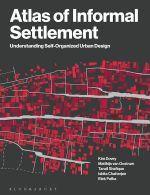Atlas of Informal Settlement: Understanding Self-Organized Urban Design

The atlas is a study of the spatial logic of informal settlement development and what shapes or is shaped by it. The heart of this book is descriptions, maps and photos of 51 informal settlements from cities around the world. For each informal settlement, this includes details of how they formed (many have long histories), how they developed over time and what engagements they had with government agencies. Data are also collected on density, street width, percentage of land that is public space, and on plot size, unit size and height and site characteristics. The atlas provides discussions on how each of these are produced and how this has changed, illustrated by several maps and photos for each informal settlement. These issues are then compared and contrasted on topics such as public open space (mostly streets and lanes) and street/lane width (how it shapes settlement design; as the study points out, each additional metre enables a different range of spatial uses and modes of access).
To quote from this atlas’s conclusions, “in the end informal settlement is a paradox. It is identified on the one hand with illegality, inferiority and insecurity; with slums and squatting - widely understood to be produced by deregulated markets and regimes of neoliberal capitalism. On the other hand informal settlement is identified as a self-organized urbanism that adds vitality, affordability, diversity, creativity and adaptability to the city – a form of radical democracy that embodies the ‘right to the city.’ Informal settlement is a mode of urban production that operates outside the control of the modern nation state yet is also produced by it. The question is not which of these narratives we might choose but how effectively we will engage with this complex adaptive assemblage.”
Book note prepared by David Satterthwaite.
Search the Book notes database
Our Book notes database contains details and summaries of all the publications included in Book notes since 1993 - with details on how to obtain/download.
Use the search form above, or visit the Book notes landing page for more options and latest content.
For a searchable database for papers in Environment and Urbanization, go to http://eau.sagepub.com/

